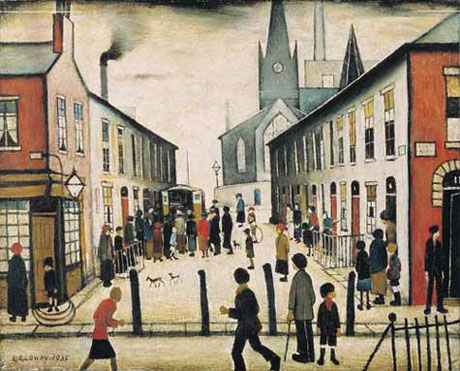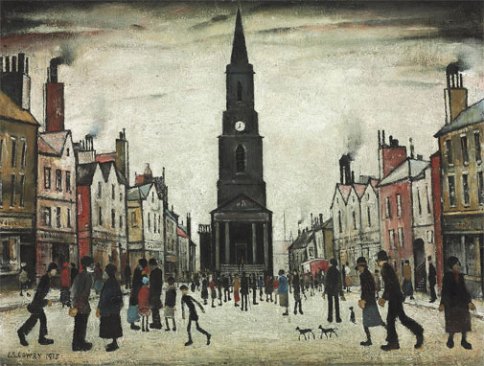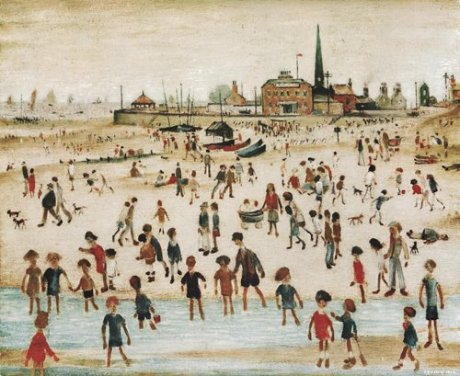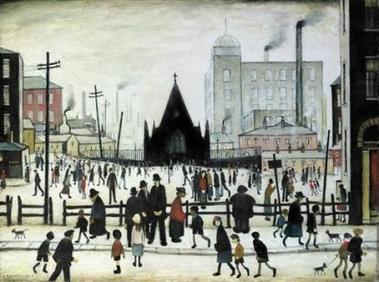There is lots of discussion today about the loss of community and how the parishes, even those that seem well attended, don’t seem to be the center or the community any more.
A common response is to look to the monastic model as an antidote. My sense is that the current interest in the much vaunted Benedict Option, in which hope for the West is placed in a Benedictine led spiritual revival is as much about fulfilling a desire for Christian community as it is for the transformation of the culture. Others have painted a picture of the medieval village with its houses clustered around the monastery as the families walk to Vespers in the gothic abbey church.
The disadvantage for such an arrangement can be that the spiritual heart is a religious community which, by its nature, is separated from the rest of the world and therefore also from the lay people who identify themselves as part of the lay extension of that community. This is not an insurmountable problem and there is nothing wrong with this if those involved don’t mind this and if the fruits of it are positive, but given the low number and often the remoteness of monastic communities, even if we put aside the difficulties, it isn’t a realistic option for most until they can retire to rural France…or Oklahoma..or wherever it may be.
I have seen people try to create lay communities of working people and their families by trying to encourage those who join to live a compound of homes where all subscribe to some modified Benedictine rule. The drawback here is that it is difficult to overcome the conflict between the demands of community and of family life – there is often a tension between the two. Some seem to manage it, but others in extreme cases can have a cultish feel to them. Such communities are by necessity strongly heirarchial if they are to avoid falling into anarchy – ultimately someone or a small group of people are in charge over decisions in daily living that effect others – this immediately creates conflict because that community authority or influence will tend interfere with, or even undermine, the natural authority of parents in the family.
Such a conflict rarely arises in parish life because beyond attendance, the parish itself does not impose rules at all beyond what the Church as a whole requires. There is no rule for parish life, that I am aware of, in the way that there are rules for religious communities. But this is also the source of a weakness for the parish as a basis of community. The connection is usually so loose that it is rare, nowadays at least, for people to feel bound to it at all.
This is where the need for a set of principles for parish community might come useful and this is what I heard described recently.
St Elias Melkite Catholic Church, in Los Gatos, California had their annual visit from the bishop, Most Reverend Nicholas J. Samra Eparchial Bishop of Newton recently. I attended Vespers and beforehand he spoke encouraging words, exercising his pastorial role as Bishop. The subject of his talk was how a parish can be a genuine community or as a put it, part of the Church and not simply a social club.
He began by going back to scripture and in particular he analysed the growth of the early Church as described by the Acts of the Apostles. He pointed out how the descriptions of the early gatherings seemed to point to four ministries that we should replicate today.
First (of course!) worship: Divine Liturgy (or Mass) and the Divine Office in the Church. Then he spoke of the need to take that worship back into the home by the establishment of the Domestic Church where the occupants of a house (not always families, this can be people living on their own or single people sharing somewhere) pray the Divine Office to their icon corner. St Elias’s pastor, Fr Sebastian Carnazzo has produced free booklets which he gives to everyone who walks into the church called Daily Prayer for Melkites. This give a simple stripped down version of the more complex, monastic derived full Morning and Evening Prayer, which families can do and by which they participate in the fuller monastic influenced form that a church might do at Vespers or Orthros. In doing this they are dispersing the liturgy across time and space and taking the Church out to their homes.
Second is social – he talked of the regular organization of social events and especially meals connected to the worship and how newcomers should be spotted and invited to attend the coffee social/meal after the Liturgy. Again, this structure of communal meals after worship can be replicated in the home. There is something wonderful about a social event in a home which is Vespers followed by a meal. He spoke also of how an apparently thriving parish can, detrimentally, also have this social element emphasized at the expense of the others so creating a social club and not a church. In the long run a parish that does this will die. When it is done properly, the hope will be that this will naturally generate friendships and social cohesion beyond the church, so creating a social fellowship amongst the parish community which supplements and derives its strength from those parish based social events and ultimately the fellowship of the Spirit and the liturgy.
Third is education. He spoke of how great a need there is for constant mystagogy of adults and instruction of the children and that churches should hold classes for both. The children, he said, should be instructed in the church, in the ideal, by a couple so that it establishes as a habit in the children the practice of looking to parents in the home for education and instruction. And that, of course, is the next step here – the education of the children in the home by the parents.
Fourth is charity – almsgiving. This is the spirit of love by which people donate time and money for the care of others in the church, in the community and beyond. Some of that time will be spent in contributing freely to ministries that provide these four parish functions. Again, we see the model being set in the parish, and then supernatural transformation of those involved so that they take their enhanced capacity to love out to their fellows. This dispersed charity, if I can call it that, participates in that which should be at its greatest in the parish.
Bishop Nicholas suggested that apart from the functions that are necessarily performed by a priest, these are ministries that lay people should take responsibility for. And in the ideal they will never be onerous for anyone. As he described it, this is a natural organization of community and each of us has charism that suits us to work within one form or another of these ministries. In short, we are made to be members of the Church and if not religious, very likely part of a parish, so when we find our natural niche by which we contribute most powerfully to parish life, we will flourish in a special way as part of it. This would be a true flowering of a liturgically centered ‘charismatic’ movement. Furthermore when you have people who are doing what comes naturally to them as part of these ministries, then we shine with the light of Christ and people will see something in us, and this will in turn attract them to parish life.
What he was presenting was a simple ‘rule’ for parish life. A set of guidelines by which if the congregation chooses to participate is likely to lead the establishment of a thriving church; and when each is in place the fifth element occurs spontaneously – evangelization.
He was in fact outlining a simple template for the project management of the new evangelization!…which is the same as the old evangelization, and is in fact the oldest evangelization.
It occured to me also, that this is a possible pattern for communities that are not monastic but perhaps bound together in some other way. Little neighborhood groups of families and single people – maybe in an apartment block – can each have their own domestic churches in their separate home and apartments, but then gather together from time to time as little parish sub-communities gathering in the home of one, reinforcing this parish template for community in all.
I think this may be a practical answer to the desire for community in modern man. Most of us are meant to be parish people, not monastic people (which is a special calling) and when life is organized on the pattern of the ideal pattern we will flourish and evangelize others.
The more it is replicated outside the church in different social groups the more it will create a bond of community for that particular grouping, while simultaneously priming those who have never been to church for participation in the parish community; and further developing the bond to it in those who already have a parish life.
Amongst those who are thinking about the decline of community and Christian culture in the West there is a tendency to assume that the establishemnt of the post-Enlightenment model of a city is the one of the culprits – perhaps industrialization and electronic communication, and the existence of giant connurbations of millions of people is part of the problem. This is the back-to-the-land, recreate-a-village outlook. There may be something to this, but I do wonder sometimes if this is not based upon an idealized view of what villages and working on the land used to be like. My instincts tell me that the sense of alienation arises not so much from the environment, as it much is within the person who is alienated. If I feel alienated then I must become more of a community person; it is by offering fellowship and community to others that I feel part of a community myself. This therefore, can happen wherever there are people. I should redirect my work into an effort to participate in the church-as-community in the fullest sense.
Again, this doesn’t mean that we all need to live in a village or even within walking distance of our local church; that parish community can be dispersed quite wide permeating a wider population base and still be strong. The old maxim – you get what you give – seems to be the operating principle here and in a city there always people nearby to whom I can offer community. Regardless of whether or not they accept it, I will change in the effort to bring it to them. Certainly, I should admit, Bishop Nicholas’s address made me ask a few questions of myself.
The paintings are all by LS Lowry, who made his name painting the industrial landscapes of the mill towns in Greater Manchester in England after the Second World War.





Parishcatalyst.org gets very much right about the best of parishes in these times without resorting either to medieval nostalgia or to modernist heresy. Their findings about what makes for a great parish (reverent worship, strong bonds of community and a commitment to works of mercy) are evidence-based and rigorous.
LikeLike
Thank you. A very interesting site. I agree wholeheartedly, this is the way to go provided that all that is transmitted through the structures described is orthodox and there is dignified and beautiful liturgy, however simple. Then parish is the natural community for most people, from which all other communities we participate in (home, neighbourhood, work) are derived and point if we get the parish right. I think that what we see all too often are the two extremes you describe the historicism of medieval (or sometimes even 1950s) nostalgia; or modernist heresies which very oftern try to forge community through the generation of fervent emotion.
LikeLike
Agreed that the parish is the fundamental unit of Catholic community life. The Church doesn’t need new forms of lay community, but rather a rediscovery of authentic community life within the geographical parish.
See recent articles about one such parish community in Hyattsville, Maryland:
http://www.newyorker.com/magazine/2017/05/01/rod-drehers-monastic-vision
http://www.npr.org/2017/04/10/522714982/catholics-build-intentional-community-of-like-minded-believers
LikeLike
Thankyou Chris!
LikeLike